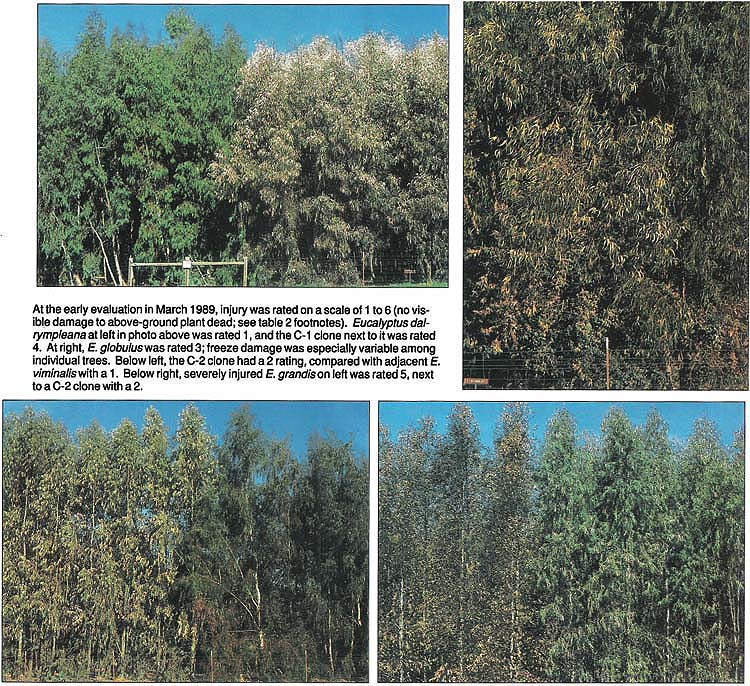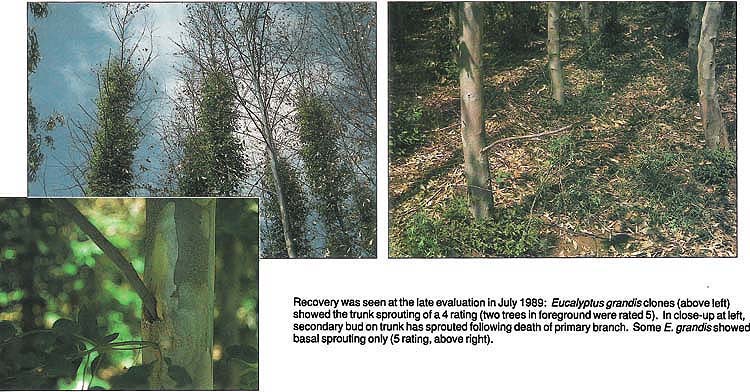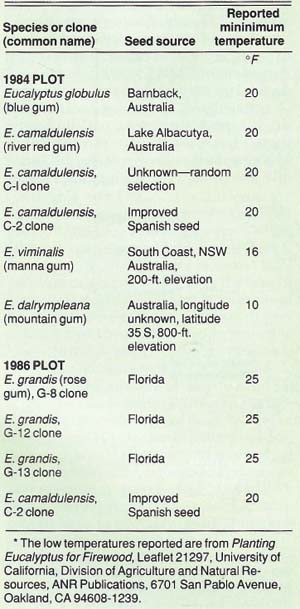All Issues
Eucalyptus shows unexpected cold tolerance
Publication Information
California Agriculture 44(2):25-27.
Published March 01, 1990
PDF | Citation | Permissions
Abstract
Although some species of eucalyptus trees in an experimental plantation were damaged in a 1989 cold snap, several species and clones survived temperatures lower than previously thought to be tolerated. The trees are in a low-elevation Sierra foothill test planting used for studies assessing fuelwood growth rates.
Full text
Eucalyptus are fast-growing hardwood trees used in California for firewood, biomass, and pulpwood, but cold sensitivity is a major limitation determining where they can be grown successfully. Many species of this genus commonly planted in California are native to the subtropical regions of Australia and are sensitive to freezing temperatures. Eucalyptus plantings throughout California have suffered damage or have been killed because the species that was planted was not sufficiently cold-tolerant for the site.
One objective of a fuelwood test planting at the Sierra Foothill Range Field Station was to compare cold tolerances of selected eucalyptus species and clones at a low-elevation foothill site. In February 1989, an arctic cold front swept through northern California, giving us the unique opportunity to test the limits of reported minimum temperatures that certain eucalyptus species could tolerate.
Fuelwood plantation cultural practices, yield data, and growth characteristics at 3.5 years of age were presented in California Agriculture, November-December 1988. Our purpose in this article is to report and illustrate comparative freeze damage, injury ratings, and short-term recovery of the eucalyptus trees in a foothill plantation.
Methods
In March 1984, six eucalyptus fuelwood species or clones were planted as seedlings in a randomized complete block design with four replications. Each replicated block contains 49 trees planted on 6- by 6- foot spacings. A second plot, without replication, was planted for observation purposes in 1986 next to the main plot. It contains four clones also planted on 6- by 6- foot spacings. The elevation at the site is 575 feet with a 7% slope.
Air temperatures were measured at standard-weather stations on the field station at elevations similar to that of the plantation. Low temperatures measured were 14°F on the mornings of February 4 and 5, 1989, and 18°F on February 6. Fourteen hours of temperatures below 20°F occurred on February 4, followed by 10 hours below 20°F the next day.
The species, clones, seed sources, and minimum temperatures below which severe freeze damage is expected are listed in table 1. Many factors influence the lowest temperature tolerated by a given species, including duration of the cold weather, the temperatures immediately preceding the cold snap, and physiological condition of the tree at the time of the freezing temperatures.
We used a freeze injury rating system with a six-point numerical scale, which was developed by University of California researchers following a severe freeze in northern and central California in 1972 (see table 2 footnotes). Injury was evaluated on two dates. The early rating on March 13, 1989, assessed the initial extent of the cold injury. Damage was visually estimated for each species by block (replicate). During the late rating on July 28, 1989, each tree was examined separately for short-term recovery.
Results
Early evaluations of the 1984 plot showed substantial damage to the C-1 clone and a lesser degree of damage to E. globulus (blue gum) (table 2). By the time of the later evaluation, the C-1 clone had made considerable recovery. The wide range in ratings within the species grown from seed (non-clones) is probably due to inherent genetic variability. Cold tolerance variability was especially evident in E. globulus, E. viminalis (manna gum), and E. camaldulensis (river red gum). At the late evaluation, 25 E. globulus, 18 E. viminalis, 8 E. camaldulensis, and 2 E. dalrympleana (mountain gum) were dead (rating six). In contrast, no C-2 clones and only 2 C-1 clones were dead at that evaluation. The dead trees were the smaller individuals within a block (table 3).
Fuelwood plots in May 1989 (above left) showed overall damage from a severe February freeze. In August 1989 (above right), after the late evaluation, trees had recovered.
At the early evaluation in March 1989, injury was rated on a scale of 1 to 6 (no visible damage to above-ground plant dead; see table 2 footnotes). Eucalyptus dalrympleana at left in photo above was rated 1, and the C-1 clone next to it was rated 4. At right, E. globulus was rated 3; freeze damage was especially variable among individual trees. Below left, the C-2 clone had a 2 rating, compared with adjacent E. viminalis with a 1. Below right, severely injured E. grandis on left was rated 5, next to a C-2 clone with a 2.
Recovery was seen at the late evaluation in July 1989: Eucalyptus grandis clones (above left) showed the trunk sprouting of a 4 rating (two trees in foreground were rated 5). In close-up at left, secondary bud on trunk has sprouted following death of primary branch. Some E. grandis showed basal sprouting only (5 rating, above right).
In the 1986 observation plot, all three E. grandis (rose gum) clones showed severe damage at the early evaluation. The C-2 clone had light damage, as in the older plot. Trunk or basal sprouts were evident on E. grandis clones by early June. By the late evaluation, trunk and basal sprouts had grown substantially.
Conclusion
The eucalyptus species at this site survived temperatures lower than the minimums previously reported for those other than E. dalrympleana. That species is reported to tolerate temperatures as low as 10°F. Freeze damage was most severe on E. grandis. Annual measurements of diameter at breast height, tree height, and volume per acre will continue in an effort to determine optimum harvest time. As we accumulate data, we will attempt to learn whether freeze damage affected annual growth.










